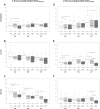Impact of energy turnover on the regulation of glucose homeostasis in healthy subjects
- PMID: 31395858
- PMCID: PMC6687696
- DOI: 10.1038/s41387-019-0089-6
Impact of energy turnover on the regulation of glucose homeostasis in healthy subjects
Erratum in
-
Correction: Impact of energy turnover on the regulation of glucose homeostasis in healthy subjects.Nutr Diabetes. 2019 Oct 7;9(1):27. doi: 10.1038/s41387-019-0094-9. Nutr Diabetes. 2019. PMID: 31591385 Free PMC article.
Abstract
Objective: Sedentary lifestyle increases the risk of type 2 diabetes. The aim of this study was to investigate the impact of different levels of energy turnover (ET; low, medium, and high level of physical activity and the corresponding energy intake) on glucose metabolism at zero energy balance, caloric restriction, and overfeeding.
Methods: Sixteen healthy individuals (13 men, 3 women, 25.1 ± 3.9 years, BMI 24.0 ± 3.2 kg/m2) participated in a randomized crossover intervention under metabolic ward conditions. Subjects passed 3 × 3 intervention days. Three levels of physical activity (PAL: low 1.3, medium 1.6, and high 1.8 achieved by walking at 4 km/h for 0, 3 × 55, or 3 × 110 min) were compared under three levels of energy balance (zero energy balance (EB): 100% of energy requirement (Ereq); caloric restriction (CR): 75% Ereq, and overfeeding (OF): 125% Ereq). Continuous interstitial glucose monitoring, C-peptide excretion, and HOMA-IR, as well as postprandial glucose and insulin were measured.
Results: Daylong glycemia and insulin secretion did not increase with higher ET at all conditions of energy balance (EB, CR, and OF), despite a correspondingly higher CHO intake (Δ low vs. high ET: +86 to 135 g of CHO/d). At CR, daylong glycemia (p = 0.02) and insulin secretion (p = 0.04) were even reduced with high compared with low ET. HOMA-IR was impaired with OF and improved with CR, whereas ET had no effect on fasting insulin sensitivity. A higher ET led to lower postprandial glucose and insulin levels under conditions of CR and OF.
Conclusion: Low-intensity physical activity can significantly improve postprandial glycemic response of healthy individuals, independent of energy balance.
Conflict of interest statement
The authors declare that they have no conflict of interest.
Figures




References
-
- Coutinho, M., Gerstein, H. C., Wang, Y. & Yusuf, S. The relationship between glucose and incident cardiovascular events. A metaregression analysis of published data from 20 studies of 95,783 individuals followed for 12.4 years. Diabetes Care22, 233–240, http://www.ncbi.nlm.nih.gov/pubmed/10333939 (1999). - PubMed
-
- Stanford, K. I. & Goodyear, L. J. Exercise and type 2 diabetes: molecular mechanisms regulating glucose uptake in skeletal muscle. Adv. Physiol. Educ. 38, 308–314, http://www.ncbi.nlm.nih.gov/pubmed/25434013 (2014). - PMC - PubMed
-
- Ploug, T., Galbo, H. & Richter, E. A. Increased muscle glucose uptake during contractions: no need for insulin. Am. J. Physiol.247(6 Pt 1), E726–E731, http://www.ncbi.nlm.nih.gov/pubmed/6391198 (1984). - PubMed
Publication types
MeSH terms
Substances
LinkOut - more resources
Full Text Sources
Medical
Research Materials

